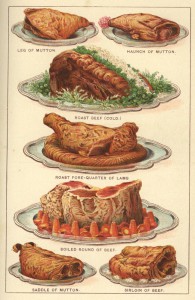Monday next will bring St. Bartholomew’s Day, the day of the traditional printer’s wayzgoose, this is a big day for book artists like me: St. Bartholomew is a patron saint of bookbinders and book artists and his day has been of significance to printers and papermakers, as well, for centuries. Goose is one traditional meal for the day, as is cheese, for St. Bart is also a patron saint of cheesemakers. But so is Bartlemas Beef, which takes some time to prepare… hence today’s post, designed to give you the time necessary to prepare a proper meal for your Wayzgoose Monday.
This recipe for a Rare Bartlemas Beef is taken from The Cook’s Guide by Hannah Wolley, printed in London in 1664. (The book’s full title is quite long: The Cook’s Guide: or, Rare receipts for cookery Published and set forth particularly for ladies and gentlewomen; being very beneficial for all those that desire the true way of dressing all sorts of flesh, fowles, and fish; the best directions for all manner of kickshaws, and the most ho-good sawces: whereby noble persons and others in their hospitalities may be gratified in their gusto’s. Phew. Perhaps the first celebratory printer’s wayzgoose came about once the typesetter triumphantly finished setting the type for this long-winded title.)
Lady Wolley calls this beef “rare” meaning fine or good. It does not refer to the cooking temperature. Judging by the three days soaking, she means for us to use salted beef, but that was 1664 and this is not and I think we can begin with fresh beef at the second step of her recipe, where the vinegar and wine is introduced. Be that as it may, here is her full 1664 recipe for a Rare Bartlemas Beef:
Take a fat Brisket piece of beef and bone it, put it into so much water as will cover it, shifting it three times a day for three dayes together, then put it into as much white wine and vinegar as will cover it, and when it hath lyen twenty-four hours take it out and drye it in a cloth, then take nutmeg, ginger, cinnamon, cloves and mace, of each a like quantity, beaten small and mingled with a good handful of salt, strew both sides of the Beef with this, and roul it up as you do Brawn, tye it as close as you can; then put it into an earthen pot, and cover it with some paste; set it in the Oven with household bread, and when it is cold, eat it with mustard and sugar.
There you have it: an old old recipe for celebrating an old old holiday. The St. Bart’s Wayzgoose is not widely celebrated today, but, considering the current boom of interest in letterpress printing and book arts, perhaps it should be. Pass the mustard, please.
The image of several fancy cuts of meat is from another old cookbook (though not nearly as old as Hannah Wolley’s): Mrs. Beeton’s Cookery Book, 1901. Thank you to the University of Michigan Digital Library for the online version of The Cook’s Guide.

I don’t tell you often enough but I so enjoy your posts. This one made me laugh becasue I was just telling someone that EVERY freakin’ person I know or am related to seems to have become vegan lately, Bless their souls, they should live and be well, but it makes eating beef in any form a rare experience (no pun intended, in fact you can;t even order dinner “rare” in may places any more) so if I had even one person to eat it with, I might try this. By the way, you probably know, but “salting and soaking” used to be the standard way for Jews to make meat “kosher.” My own non-religious mother did it, because, she claimed, it made the meat “taste better.”
Thank you, Judith! I did not know that, so I appreciate the insight. I think the only thing in a Wayzgoose feast that would be vegan friendly would be the ale and mead (and perhaps even the mead would be problematic?). More on that in Monday’s chapter.
Hi John,
Thank you for posting this recipe. I think it would probably be delicious, and I might very well try it out.
On a related subject, I am constantly disappointed, when I come to a Wayzgoose, and no goose is served! I have not yet given up hope, though. I think someone is sure to see the righteousness of this, and that it will happen, probably during my life time!
It was the printers, as I understand it, who would typically have a meal of roast goose on Bartlemas. They would have the day off and get a little extra pay, which most often went toward a goose for the day’s festivity.
You’re a printer, aren’t you, Rachel? It may be that you’ll have to make the goose!
This recipe seemed familiar to me. I checked my recipes and found that this is similar to one I use for sour beef, also known as saurbraten. The roast is soaked in vinegar and pickling spices for three days in the refrigerator, then cooked as a pot roast – well done. After cooking the meat, spices are removed. The remaining liquid is used to prepare a gingersnap gravy. Saurbraten is served warm, with the gingersnap gravy and dumplings. It is very good!
Gingersnap gravy?!? This whole meal sounds delicious, Dee. I am currently in the wine and vinegar stage and we’ll see how things turn out tomorrow.
[…] this past weekend you read the previous chapter of the Convivio Book of Days blog, which supplied a recipe, first published in 1664, for a rare […]